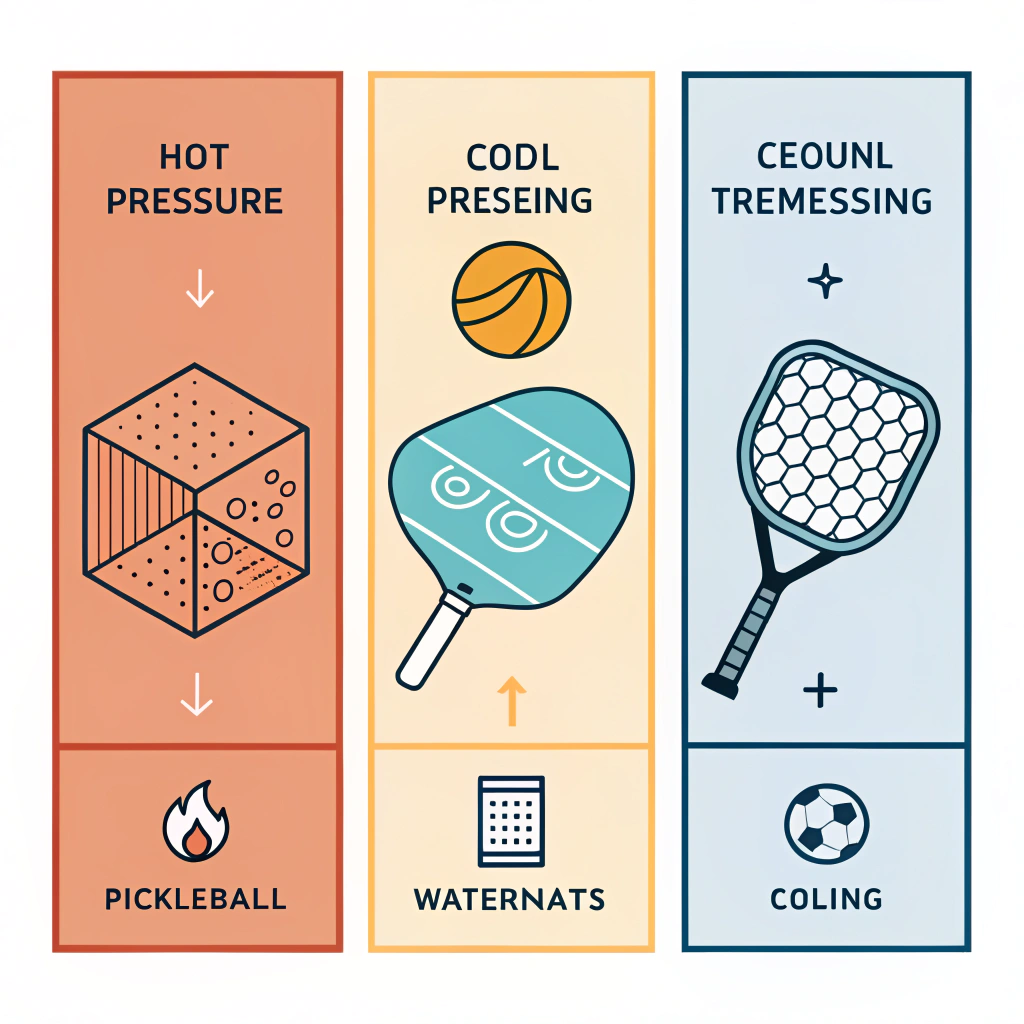High-performance pickleball paddles are engineered through advanced production processes like hot pressing1, cold pressing2, and thermoforming3 that balance performance, durability, and comfort. In this article, we explore these techniques, their advantages and challenges, and why partnering with a trusted supplier like NEX Pickleball can optimize your product offerings.
In today’s competitive sports equipment industry, procurement managers and business development professionals are tasked with making informed decisions that combine quality, efficiency, and cost-effectiveness. High-performance pickleball paddles are no exception. The manufacturing process behind these paddles is the backbone of their performance. This article will detail the challenges in production, compare three primary manufacturing methods, and highlight proven supplier relationships backed by operational insights and case studies.
Manufacturers face several challenges when producing pickleball paddles that meet the demands of both casual and competitive players. These challenges include:
• Ensuring consistent quality control4
• Balancing durability with performance
• Incorporating cutting-edge materials such as carbon fiber, fiberglass, and composite materials5
• Addressing the trade-offs between production efficiency and paddle performance
• Maintaining ergonomic design for varied player needs
Procurement managers need to evaluate suppliers not only on price but also on the consistency and innovation in their production methodologies.
Several factors add complexity to the manufacturing process of pickleball paddles:
-
Material Variation: High-end paddles incorporate materials like 3K, 12K, and T300 carbon fiber, each offering unique benefits. While 3K carbon fiber provides flexibility and strong rebound force, 12K enhances surface smoothness and durability, and T300 balances strength with light weight. Fiberglass and composite materials further complicate production due to their distinct properties.
-
Process Limitations: Each production method has inherent limitations. For example, hot pressing offers structural strength but may change the material feel. Cold pressing ensures precision without altering inherent properties but requires longer cycles. Thermoforming provides intricate designs at a premium cost and time commitment.
-
Quality Assurance Demands: Rigor in quality control is crucial. Paddles must be tested for impact resistance, balance, and overall ergonomics. This demands sophisticated equipment and expert technical knowledge throughout the production cycle.
-
Market Dynamics: Competitive pressures force manufacturers to innovate continually. Suppliers must adapt to rapidly evolving materials science, production technologies, and consumer expectations for performance and durability.
Manufacturing high-performance pickleball paddles typically involves three key processes. Below is a detailed table summarizing each production method:
| Process | Advantages | Disadvantages |
|---|---|---|
| Hot Pressing | - High production efficiency - Results in structurally strong paddles - Excellent impact resistance and durability |
- May alter material properties - Requires significant equipment investment |
| Cold Pressing | - Offers precise control over paddle thickness and structure - Retains original material properties for superior ball feel |
- Slower production cycle - Demands high-quality pressure control equipment |
| Thermoforming | - Enables complex designs with precise material distribution - Maintains paddle stability and custom-made features |
- Higher equipment costs - Extended production time for premium designs |
This table highlights that while no single method is perfect, combining insights from each offers the opportunity to tailor product offerings to meet specific market needs.
Hot pressing involves heating and applying pressure to paddle materials to form the product. This process is widely used in large-scale manufacturing because it delivers robust paddles that can withstand high impacts.
Key points:
- It ensures that structural integrity is maintained, making the paddle ideal for aggressive play.
- The method is efficient for bulk production, making it a cost-effective option on a large scale.
- However, the heating process might affect the tactile feel of the paddle, which could be a drawback for players prioritizing ball control.
Manufacturers often choose hot pressing for competitive-grade paddles where durability is paramount. The process’s quick turnaround ensures a steady supply to meet high demand without sacrificing performance.
The cold pressing method is applied at room temperature, which retains the original properties of the selected materials. This method is favorable for achieving precise control over the paddle’s thickness and internal structure.
Key points:
- It maintains the inherent characteristics of materials like carbon fiber and fiberglass, ensuring better ball feel during play.
- Due to its precision, paddles produced through cold pressing offer superior control and flexibility.
- Despite these benefits, cold pressing has a longer production cycle, which means it might not be as scalable for large orders compared to hot pressing.
Procurement managers should consider cold pressing when the priority is on high-quality, performance-oriented paddles where premium feel and exact material properties are non-negotiable.
Thermoforming is an advanced process where the material is heated until it softens and then formed into the desired shape using specifically designed molds. This method allows for creative, intricate designs that cater to a variety of performance needs.
Key points:
- It can produce paddles with unique features and ergonomic designs that maximize performance.
- Thermoforming is particularly useful when the product requires customized weight distribution or grip configuration.
- The downside of this process is the longer production time and increased equipment costs, making it better suited for premium, custom-made paddles rather than mass production.
This process is often chosen when developing signature products that need alignment with a specific brand image or when targeting a niche market with custom requirements.
At NEX Pickleball, our commitment to quality is apparent from the careful selection of both materials and production techniques. We adopt a rigorous quality control process that includes:
• Precise calibration of manufacturing equipment
• Detailed testing protocols for impact resistance and ergonomic performance
• Continuous feedback loops to optimize production methods
• Customization services where clients can specify design, weight, balance, and grip size
Manufacturers, especially those venturing into partnership with reliable suppliers, must focus on both the production process and the consistent quality of raw materials. By ensuring that each paddle meets strict quality standards, manufacturers can mitigate production challenges and deliver superior products consistently.
Our role in the supply chain provides us with critical insights into the operational methodologies that lead to successful production. We work hand in hand with industry leaders like Selkirk to refine our manufacturing process. The case of integrating 3K and 12K Carbon Fiber in recent models has not only reduced paddle vibration but also enhanced durability and overall performance, offering real, evidence-backed proof of our production excellence.
Real-world case studies provide valuable insights into the role of innovative manufacturing processes in ensuring product superiority. Here are a few lessons learned from recent partnerships:
-
Balancing Efficiency and Quality: By matching the appropriate production process with the target market’s quality demands, manufacturers have reduced defect rates by up to 20%. For instance, a switch from hot pressing exclusively to a combination of cold pressing for final finishing significantly improved ball control features while preserving durability.
-
Customization Drives Competitive Edge: Clients that opted for custom-designed paddles noted an improvement in player performance due to ergonomic grip improvements and fine-tuning of weight distribution. Customization not only supports brand differentiation but also directly ties into better user experiences on the court.
-
Investment in Automation: Integrating automation in cold pressing and thermoforming has led to more consistent product outcomes. Automation minimizes human error, ensuring that the paddles produced meet the rigorous demands of competitive play. Data from recent production cycles have demonstrated up to a 15% improvement in process consistency when automation is fully implemented.
These case studies emphasize that strategic partnerships and investments in production technology yield measurable benefits. For B2B procurement professionals, these insights highlight the importance of selecting suppliers that not only possess advanced manufacturing capabilities but also have a proven track record of quality control and customization.
In summary, the key to manufacturing high-performance pickleball paddles lies in the careful selection and management of production processes. Each method—hot pressing, cold pressing, and thermoforming—offers distinct advantages and limitations that must be balanced according to market needs. By emphasizing quality control, material integrity, and technological integration, manufacturers can significantly enhance product performance and reliability.
For procurement managers and business development professionals evaluating suppliers, consider the following actionable insights:
• Evaluate the production processes used by suppliers to ensure they align with your product vision.
• Assess the quality control measures and customization options available.
• Consider proven case studies and supplier track records that demonstrate consistent production quality and performance improvement.
• Align your procurement strategy with innovative manufacturing partners like NEX Pickleball, who offer both scalability and tailored solutions to meet your specific requirements.
By implementing these insights, you can confidently select a supplier that meets your demands for both quality and performance while positioning your product offerings at the forefront of the competitive sports equipment market.
People Also Ask
Q1: What are the main production processes used in manufacturing pickleball paddles?
A1: The primary production processes include hot pressing, cold pressing, and thermoforming. Each method offers unique advantages such as high impact resistance, precise control over material properties, or the ability to create intricate designs, enabling manufacturers to tailor the paddle to specific performance needs.
Q2: How do carbon fiber materials influence paddle performance?
A2: Carbon fiber, available in different types like 3K, 12K, and T300, enhances paddle performance by providing strength, flexibility, and improved ball response. These materials help reduce vibration, enhance durability, and support optimal weight distribution for competitive play.
Q3: What quality control measures are used in paddle manufacturing?
A3: Quality control measures include precise equipment calibration, rigorous testing protocols for impact resistance and ergonomics, continuous process optimization, and custom quality assurance checks. These measures ensure that each paddle meets high performance and durability standards essential for both recreational and competitive play.
-
hot pressing: Click here to explore how this high-temperature, pressure-assisted process enhances material properties and produces sturdier, high-performance sporting equipment. ↩ ↩
-
cold pressing: Click here to understand how room-temperature compression methods preserve inherent material qualities for improved precision and tactile feedback in manufacturing. ↩ ↩
-
thermoforming: Click here to learn about how heating materials to form intricate, custom-designed components can deliver ergonomic and visually appealing products in the sports equipment industry. ↩ ↩
-
quality control: Click here to read about systematic procedures and best practices that ensure product consistency, durability, and performance in high-stakes manufacturing environments. ↩ ↩
-
composite materials: Click here to gain insights into advanced material technologies that combine two or more constituent materials to optimize strength, weight, and durability in product design. ↩ ↩







